Quinoa salad, celebrated for its rich nutritional profile, is an ideal choice for those seeking to combine health and convenience in their meals. This guide delves into the essentials of mastering quinoa salad meal prep, offering insights into selecting fresh ingredients and perfecting cooking techniques that promise both taste and nutrition. By understanding the right tools and methods, you can create diverse and flavorful quinoa salads. Learn practical tips for storing your creations while maintaining freshness throughout the week. Whether prepping for one or scaling up for a family, this comprehensive guide ensures your journey to quick, healthy eating is both enjoyable and efficient.
Key Takeaways
- Mastering quinoa salad meal prep enhances quick and healthy eating by integrating nutrient-dense superfoods into your diet.
- Utilizing the right tools and selecting fresh, complementary ingredients can significantly streamline meal preparation.
- Understanding the perfect way to prepare and cook quinoa ensures better texture and flavor in your salads.
- Adapting meal prep strategies for larger families can improve efficiency and encourage healthier eating habits.
- Proper storage techniques maintain the freshness and quality of your pre-prepared meals throughout the week.
The Nutritional Benefits of Quinoa

Quinoa is often hailed as a superfood due to its impressive nutrient profile that supports a balanced diet. It is one of the few plant-based foods that provides a complete source of protein, containing all nine essential amino acids. This makes it an ideal choice for vegetarians and vegans seeking to increase their protein intake without relying on animal products.
Furthermore, quinoa is an excellent source of fiber, providing over 5 grams per cup when cooked. This high fiber content aids in digestion, helps maintain healthy blood sugar levels, and supports heart health by reducing cholesterol. Additionally, quinoa is naturally gluten-free, making it a suitable grain alternative for those with gluten sensitivity or celiac disease.
In terms of vitamins and minerals, quinoa is rich in magnesium, phosphorus, manganese, zinc, and iron. Magnesium is crucial for nerve and muscle function, while iron supports the production of hemoglobin, which is vital for transporting oxygen in the blood. Antioxidants present in quinoa, such as quercetin and kaempferol, help protect the body from oxidative stress and inflammation.
Moreover, quinoa contains a balanced amount of carbohydrates and healthy fats that provide sustained energy, making it an excellent choice for active individuals and those managing their weight. Integrating quinoa into your diet not only enhances nutrient intake but also contributes to overall well-being, making it a valuable addition to any meal prep routine.
With its myriad of nutritional benefits, quinoa serves as a powerful ingredient, ensuring that your salad meal prep is both healthful and satisfying.
Essential Tools for Meal Prep

For successful quinoa salad meal prep, having the right tools can make the process efficient and enjoyable. Below are the essential tools you will need:
-
Quality Knives: A chef’s knife is indispensable for chopping vegetables, herbs, and proteins. Ensure it’s well-sharpened to reduce prep time and enhance precision.
-
Cutting Board: Invest in a sturdy cutting board, preferably one made from bamboo or plastic. These materials are durable and easy to clean, making them ideal for handling various ingredients.
-
Measuring Cups and Spoons: Accurate measurements are crucial for maintaining the balance of flavors in your quinoa salad. Use these tools to measure grains, dressings, and spices precisely.
-
Salad Spinner: A salad spinner is beneficial for washing and drying leafy greens swiftly. Properly dried vegetables are essential for preventing watered-down salads.
-
Mixing Bowls: Use bowls in a range of sizes for mixing and tossing ingredients. Opt for stainless steel or glass bowls for their durability and ease of cleaning.
-
Storage Containers: Select airtight containers of various sizes to store individual portions of your quinoa salad. Glass containers are advisable as they are non-reactive and can be used in the microwave.
-
Pot and Strainer: A medium-sized pot is essential for cooking quinoa, while a fine-mesh strainer ensures thorough rinsing to prevent bitterness.
-
Blender or Food Processor: Although not crucial, having a blender or food processor can be valuable for creating smooth, homemade dressings or quickly chopping vegetables.
Equipping your kitchen with these tools will significantly streamline your meal prep process, ensuring you can focus more on creativity and flavor rather than logistics.
Choosing the Right Ingredients
When crafting a quinoa salad, the selection of quality ingredients is crucial to achieve both deliciousness and nutrition. Begin with choosing fresh produce. Opt for leafy greens like kale or spinach, which are high in vitamins A and C. Supplement these with your favorite vegetables such as cherry tomatoes, cucumbers, and bell peppers, celebrated for their rich flavors and crunch.
Protein sources are essential companions to quinoa. Consider adding cooked chickpeas, black beans, or edamame. These options provide not only protein but also essential fibers. For those fond of dairy, feta or goat cheese can infuse a creamy texture, while nuts like almonds or walnuts offer a satisfying crunch.
Fruits add a delightful contrast in taste and texture. Diced apples, orange segments, or a handful of dried cranberries introduce natural sweetness and vibrancy to your salad.
Addressing herbs and spices is equally significant. Fresh herbs such as cilantro or parsley can elevate the salad’s freshness. A sprinkle of cumin or paprika can contribute a subtle depth of flavor, complementing the nutty essence of quinoa.
The dressing ties all these elements together. Favor olive oil-based dressings for their heart-healthy benefits. Combine with lemon juice, mustard, or a dash of honey for a balanced and palatable dressing.
Selecting ingredients that not only suit your taste preferences but also complement the health profile of quinoa is the key to a successful quinoa salad. By doing so, you ensure that every meal is both a culinary triumph and a nourishing delight.
Preparing Quinoa Perfectly
To achieve the perfect bowl of quinoa, begin by thoroughly rinsing the grains under cold running water. This crucial step helps remove the natural coating known as saponin, which can impart a bitter flavor. Use a fine-mesh sieve to ensure none of the small grains are lost in the process.
Next, measure one cup of quinoa and two cups of water, keeping the 1:2 ratio consistent for optimal texture. Place them in a medium saucepan and bring to a boil over medium-high heat. Once boiling, reduce the heat to a simmer, covering the saucepan with a tight-fitting lid. Allow the quinoa to cook undisturbed for about 15 minutes, or until the grains are tender and have absorbed all the liquid.
After cooking, remove the saucepan from heat and let it stand, covered, for an additional 5 minutes. This resting period ensures the grains are light and fluffy, enhancing the quinoa’s natural nuttiness.
For added texture and flavor variations, consider toasting the quinoa in a dry pan before cooking. Gently stir the grains over medium heat until they emit a nutty aroma, then proceed with the standard cooking method. Toasting brings out the earthy flavor of quinoa, adding depth to your salad.
Whether used as a base for hearty salads or as an accompaniment to protein-rich dishes, perfect preparation ensures that quinoa remains a versatile and delightful component in your meal repertoire. With these precise methods, you can consistently enjoy the subtle yet rich flavors of perfectly cooked quinoa.
Creating Diverse Quinoa Salad Recipes

Exploring diverse quinoa salad recipes can transform your meal prep routine, broadening your culinary horizons while ensuring nutritional variety. Here’s how to experiment with various flavors and styles to craft unique and enjoyable quinoa salads.
Fusion-Inspired Flavors: Incorporating global cuisines can elevate your salad experience. Consider adding Mediterranean ingredients like cherry tomatoes, olives, and feta for a refreshingly tangy twist. Alternatively, infuse Asian flavors by tossing in edamame, shredded carrot, and a sesame-ginger dressing.
Seasonal Ingredients: Aligning your salads with seasonal produce can enhance freshness and flavor. In summer, opt for corn, zucchini, and fresh basil. During the fall, incorporate roasted butternut squash, cranberries, and pecans for a heartier salad.
Protein Powerhouses: To make your quinoa salads more filling, integrate a variety of protein sources. Grilled chicken, chickpeas, or black beans can boost the nutritional content. For a plant-based option, add tofu or tempeh, marinated to your preference.
Dressings and Herbed Enhancements: Crafting homemade dressings can personalize your quinoa salad. A simple lemon-tahini or balsamic vinaigrette adds zest. Fresh herbs like mint, parsley, or cilantro can further refine flavors without overpowering the core ingredients.
Textural Diversity: Balancing textures is key to a satisfying quinoa salad. Add crunch with nuts or seeds, such as almonds or pumpkin seeds. Juxtapose this with creamy elements like avocado or goat cheese to ensure a delightful eating experience.
By creatively combining these elements, you can enjoy a wide array of flavorful quinoa salads, making healthy eating both enjoyable and sustainable.
Storing and Serving Prepared Meals

Properly storing and serving your prepared quinoa salads is crucial to preserving their flavors and nutritional value. By following best practices for storage, you can enjoy fresh and delicious meals throughout the week.
To store your quinoa salad effectively, begin by allowing the quinoa to cool to room temperature before refrigeration. This prevents condensation, which can make the salad soggy. Store the salad in airtight containers to maintain freshness and prevent contamination. Glass containers are particularly advantageous due to their airtight seals and absence of toxins found in some plastics.
Consider placing moisture-sensitive ingredients such as greens and nuts in separate containers or compartments. This strategy will help them retain their texture when it’s time to serve. A layering technique is also beneficial; place heavier ingredients at the bottom, and greens or herbs on top. This method protects the delicate ingredients from absorbing too much moisture.
When it comes to serving prepared meals, versatility is your ally. Quinoa salads can be consumed cold or warmed gently, depending on your preference. Add any last-minute ingredients like dressings, nuts, or cheese just before serving to enhance flavor and texture.
For those seeking variety in their meals, changing up the way you serve your quinoa salad can also work wonders. Consider serving it in a wrap for a portable lunch option or pairing it with a protein source such as grilled chicken or tofu for a more filling meal. Each serving style offers unique flavors, making mealtime both interesting and nutritious.
Tips for Maintaining Freshness
To keep your quinoa salad meal prep fresh and vibrant throughout the week, mastering the art of proper storage and handling is essential. Here are some effective strategies for maintaining freshness:
-
Ensure Adequate Cooling and Storage: After preparing your quinoa salad, allow it to cool to room temperature before refrigerating. This prevents condensation from creating excess moisture, which can degrade quality. Store in airtight containers to preserve texture and flavor.
-
Opt for Separation of Ingredients: For salads that remain crisp, consider storing ingredients separately and combining them just before serving. This is particularly useful for items like nuts, seeds, and dressings, which can cause other ingredients to become soggy if mixed too soon.
-
Use Fresh and High-Quality Ingredients: Begin your meal prep with the freshest produce possible, ensuring that vegetables and herbs have a longer shelf life. Regularly check expiration dates and quality at purchase.
-
Portion Control for Optimal Use: Divide your prepared salad into individual portions. This method minimizes exposure to air each time you retrieve a serving, maintaining freshness.
-
Employ the Use of Natural Preservatives: Utilize natural ingredients known for their preserving qualities, such as olive oil and lemon juice. These not only enhance flavor but also help maintain the vibrancy of your salad.
“Keeping ingredients separate not only preserves freshness but adds a dimension of crispness to each bite,” suggests culinary experts.
By following these practices, you can enjoy a fresh and flavorful quinoa salad throughout the week, ensuring every meal is as satisfying as the first.
Scaling Up Meal Prep for Families

Preparing meals for a single individual or a couple can often be straightforward; however, scaling up quinoa salad meal prep for larger families or groups requires strategic planning and efficient execution. By following a few essential tips, you can seamlessly integrate this healthy and versatile dish into your family’s weekly meal routine.
Plan Variations to Suit Different Preferences: Larger households are likely to have a variety of taste preferences. To cater to this diversity, consider preparing a base quinoa salad that can be easily customized. Offer a selection of toppings such as roasted vegetables, grilled chicken, or tofu, and different dressings to accommodate personal tastes.
Economize by Buying in Bulk: Purchasing quinoa and other common ingredients in bulk not only reduces costs but also ensures you have a steady supply ready for meal prep. This approach is particularly beneficial for large families, where portion sizes need to be adjusted.
Utilize Large Batch Cooking Techniques: When cooking quinoa, always make more than needed. It can be easily stored in the fridge and quickly turned into a new dish with minimal effort. This technique saves time and energy throughout the week.
Efficient Use of Space and Tools: Make use of large pots, wide mixing bowls, and sizeable storage containers to handle increased quantities effectively. Having the right equipment simplifies the preparation process and prevents overcrowding during storage.
By implementing these strategies, you can elevate your meal prep routine, ensuring that each family member enjoys a nutritious and delicious quinoa salad tailored to their preferences, while keeping the process efficient and economical.
Conclusion
Mastering quinoa salad meal prep opens the door to quick, healthy eating that is both delicious and convenient. By understanding the nutritional benefits of quinoa and employing essential tools, you can craft a variety of flavorful recipes that cater to different tastes. Proper preparation and storage techniques ensure freshness, making it easier to maintain a nutritious diet throughout the week. As you incorporate these strategies into your routine, you’ll find yourself prepared to embrace a healthier lifestyle, confident in your ability to provide wholesome meals, even on the busiest days.
Frequently Asked Questions
How long can quinoa salad be stored in the refrigerator?
Quinoa salad can typically be stored in the refrigerator for up to five days. To maintain freshness, use airtight containers and keep the salad at a consistent cool temperature.
Can I freeze quinoa salad for meal prep?
Freezing quinoa salad is not recommended as it can affect the texture and flavor. Instead, cook and freeze plain quinoa in portions, then prepare fresh salad ingredients when needed.
What is the recommended serving size for a quinoa salad?
A standard serving size for quinoa salad is about one cup. This portion provides ample nutrients and balanced flavors, aligning with most dietary requirements for a single meal.
How do I prevent my quinoa salad from becoming soggy?
To prevent sogginess, ensure quinoa is thoroughly cooled before mixing with other ingredients. Additionally, keep dressings separate and add them just before serving.
Are there any ingredients I should avoid in quinoa salad for longer storage?
Avoid using ingredients that spoil quickly, such as avocados or certain fresh herbs. Opt for more stable ingredients like beans, bell peppers, and onions for longer-lasting salads.


